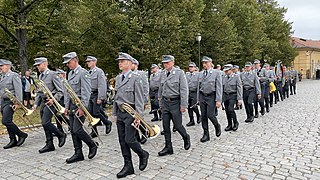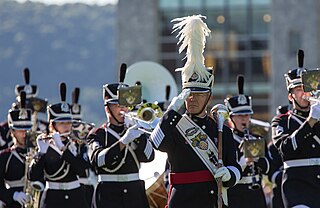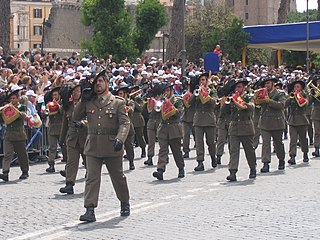
A musical ensemble, also known as a music group or musical group, is a group of people who perform instrumental and/or vocal music, with the ensemble typically known by a distinct name. Some music ensembles consist solely of instrumentalists, such as the jazz quartet or the orchestra. Other music ensembles consist solely of singers, such as choirs and doo wop groups. In both popular music and classical music, there are ensembles in which both instrumentalists and singers perform, such as the rock band or the Baroque chamber group for basso continuo and one or more singers. In classical music, trios or quartets either blend the sounds of musical instrument families or group together instruments from the same instrument family, such as string ensembles or wind ensembles. Some ensembles blend the sounds of a variety of instrument families, such as the orchestra, which uses a string section, brass instruments, woodwinds and percussion instruments, or the concert band, which uses brass, woodwinds and percussion.

The bugle is a simple signaling brass instrument with a wide conical bore. It normally has no valves or other pitch-altering devices, and is thus limited to its natural harmonic notes, and pitch is controlled entirely by varying the air and embouchure.

A military band is a group of personnel that performs musical duties for military functions, usually for the armed forces. A typical military band consists mostly of wind and percussion instruments. The conductor of a band commonly bears the title of Bandmaster or Music director. Ottoman military bands are thought to be the oldest variety of military marching bands in the world, dating from the 13th century.

A concert band, also called a wind band, wind ensemble, wind symphony, wind orchestra, symphonic band, the symphonic winds, or symphonic wind ensemble, is a performing ensemble consisting of members of the woodwind, brass, and percussion families of instruments, and occasionally including the harp, double bass, or bass guitar. On rare occasions, additional, non-traditional instruments may be added to such ensembles such as piano, synthesizer, or electric guitar.

Classic drum and bugle corps are musical ensembles that descended from military bugle and drum units returning from World War I and succeeding wars. Traditionally, drum and bugle corps served as signaling units as early as before the American Civil War, with these signaling units having descended in some fashion from ancient drum and fife corps. With the advent of the radio, bugle signaling units became obsolete and surplus equipment was sold to veteran organizations. These organizations formed drum and bugle corps of civilians and veterans, and the corps performed in community events and local celebrations. Over time, rivalries between corps emerged and the competitive drum and bugle corps circuit evolved.
Banda is a subgenre of regional Mexican music and type of ensemble in which wind and percussion instruments are performed.

Marching brass instruments are brass instruments specially designed to be played while moving. Most instruments do not have a marching version - only the following have marching versions:

A brass band is a musical ensemble generally consisting entirely of brass instruments, most often with a percussion section. Ensembles that include brass and woodwind instruments can in certain traditions also be termed brass bands, but may be more correctly termed military bands, concert bands, or "brass and reed" bands.

Martial music or military music is a specific genre of music intended for use in military settings performed by professional soldiers called field musicians. Much of the military music has been composed to announce military events as with bugle calls and fanfares, or accompany marching formations with drum cadences, or mark special occasions as by military bands. However, music has been employed in battle for centuries, sometimes to intimidate the enemy and other times to encourage combatants, or to assist in organization and timing of actions in warfare. Depending on the culture, a variety of percussion and musical instruments have been used, such as drums, fifes, bugles, trumpets or other horns, bagpipes, triangles, cymbals, as well as larger military bands or full orchestras. Although some martial music has been composed in written form, other music has been developed or taught by ear, such as bugle calls or drum cadences, relying on group memory to coordinate the sounds.

A Corps of Drums, sometimes known as a Fife and Drum Corps, Fifes and Drums or Field Music is a traditional European military music formation. In contrast to a military band, a Corps of Drums' primary role is communication. Historically, music was used as signaling device throughout the day for keeping the march tempo and delivering commands. Today, the primary role of a Corps of Drums is ceremonial, performing in parades and military ceremonies. Besides drums, this formation may contain a variety of instruments,including trumpets, bugles, and fifes.
An offstage instrument or choir part in classical music is a sound effect used in orchestral and opera which is created by having one or more instrumentalists from a symphony orchestra or opera orchestra play a note, melody, or rhythm from behind the stage, or having a choir of singers sing a melody from behind the stage.

A fanfare orchestra is a type of brass band consisting of the entire saxophone family, trumpets, trombones, euphoniums, baritone horns, flugelhorns and alto/tenor- or F-horns, as well as percussion. They are seldom seen outside of Europe, with a high concentration of these bands in Belgium and the Netherlands, many of them civil bands with a few Dutch bands also serving the Armed forces of the Netherlands and its veterans.

Canadian military bands are a group of personnel in the Canadian Armed Forces (CAF) that performs musical duties for military functions. Military bands form a part of the Music Branch of the CAF, composed of six full-time professional Regular Force bands, 15 Regular Force voluntary bands, and 53 part-time reserve force bands. Bands of the Music Branch are often badged with the unit or Canadian Forces base insignia that they support.

The West Point Band is the U.S. Army's oldest active band and the oldest unit at the United States Military Academy, traces its roots to the American Revolutionary War. At that time, fifers and drummers were stationed with companies of minutemen on Constitution Island, across the river from West Point. In 1778, General Samuel Holden Parsons' 1st Connecticut Brigade crossed the Hudson River and established West Point as a permanent military post. After the American Revolution, Congress disbanded most of the Continental Army, but "the 55 men at West Point", members of the 2nd Continental Artillery, remained as they were. Among their ranks stood at least one drummer and one fifer, who alone maintained the tradition of military music at West Point.

A fanfare trumpet, also called a herald trumpet, is a brass instrument similar to but longer than a trumpet, capable of playing specially composed fanfares. Its extra length can also accommodate a small ceremonial banner that can be mounted on it.

The Music of the Foreign Legion, formerly known as the Principal Music of the Foreign Legion is a Military band of the French Foreign Legion.

The Brazilian Marine Pipes, Drum and Bugle Corps is the only field music formation in service in the Brazilian Marine Corps and within the wider Brazilian Navy, and one of a few active formations today in service in the Brazilian Armed Forces. Formed in 1822 on the basis of the field music formations of the present day Portuguese Marine Corps stationed in Brazil, it is also the oldest in South America.

A mounted band is a military or civilian musical ensemble composed of musician playing their instruments while being mounted on an animal. The instrumentation of these bands are limited, with the musician having to play their instrument, as well as steer the animal to the designated location. Most mounted bands, therefore, use instruments that can easily be held, such as bugles, horns, and Fanfare trumpets. Timpani and glockenspiels are also a common feature, usually located at the head of a band. Although a band that is mounted on any member of the families Equidae and Camelidae are considered to be a mounted band, horses are most commonly used, mostly being employed in military bands in Europe, North and South America, and some parts of Asia.

Italian Bersaglieri Bands are military bands that belong to the Bersaglieri Corps of the Italian Army. These brass bands are notable for their marching style, playing their instruments while on a jogging pace ahead of their attached units on parade. In the 1800s, every unit in the Bersaglieri had a band known as a "fanfara" or fanfare. Today, this is not the case, with only four Bersaglieri regiments retaining a "fanfara". A fanfare of the Bersaglieri plays exclusively brass.

The military bands of the United Kingdom are musical units that serve for protocol and ceremonial duties as part of the British Armed Forces. They have been the basis and inspiration for many military bands in the former British Empire and the larger Commonwealth of Nations as well as musical organizations in other countries. Military musical units with British influence include United States military bands, the Japan Ground Self-Defense Force Music Corps and the Military Band of Athens. British military bands are controlled by the military music departments of the three services that compose the armed forces. These include the Royal Marines Band Service, the Royal Corps of Army Music, and the Royal Air Force Music Services. British style brass bands and carnival bands were then and are currently inspired by the British Armed Forces and its brass bands, especially of the Army's regular and reserve formations, as they follow a similar format as it relates to brass and percussion instruments.





















